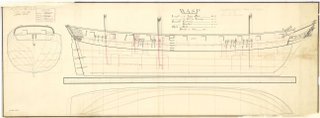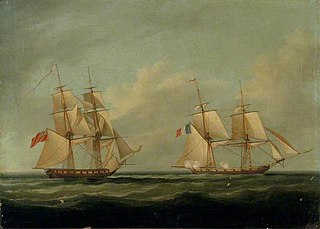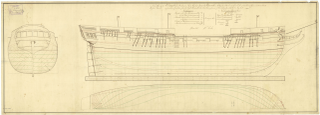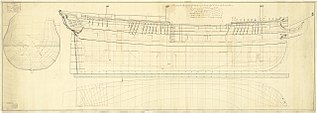Heureux was a 22-gun French privateer brig that the British captured in 1800. She served with the Royal Navy as the 22-gun post ship HMS Heureux. She captured numerous French and Spanish privateers and merchant vessels in the Caribbean Sea before she was lost at sea in 1806. Her fate remains a mystery to this day.

HMS Hydra launched in 1797 was a fifth-rate frigate of the Royal Navy. From 1813 to 1817 she served as a troopship. She was sold in 1820.
Launched on 21 May 1797, GB No. 21 was renamed HMS Defender on 7 August the same year. She was a 12-gun Courser-class gun-brig built for the British Royal Navy at Limehouse and disposed of in 1802.
HMS Eurydice was a 24-gun Porcupine-class post ship of the Royal Navy built in 1781 and broken up in 1834. During her long career she saw service in the American War of Independence, the French Revolutionary Wars and the Napoleonic Wars. She captured a number of enemy privateers and served in the East and West Indies, the Mediterranean and British and American waters.

HMS Juno was a Royal Navy 32-gun Amazon-class fifth rate. This frigate served during the American War of Independence, and the French Revolutionary and Napoleonic Wars.

Égyptienne was a French frigate launched at Toulon in 1799. Her first service was in Napoleon's Egyptian campaign of 1801, in which the British captured her at Alexandria. She famously carried the Rosetta Stone to Woolwich, and then the Admiralty commissioned her into the Royal Navy as the 40-gun fifth-rate frigate HMS Egyptienne. She served in a number of single-ship actions before being reduced to harbour service in 1807, and was sold for breaking in 1817.

HMS Wasp was an 18-gun sloop of the British Royal Navy. She was formerly the French naval brig Guêpe, which the Navy captured in 1800. She served during the French Revolutionary and Napoleonic Wars, and was sold out of naval service in 1811.

HMS Curieux was a French corvette launched in September 1800 at Saint-Malo to a design by François Pestel, and carrying sixteen 6-pounder guns. She was commissioned under Capitaine de frégate Joseph-Marie-Emmanuel Cordier. The British captured her in 1804 in a cutting-out action at Martinique. In her five-year British career Curieux captured several French privateers and engaged in two notable single-ship actions, also against privateers. In the first she captured Dame Ernouf; in the second, she took heavy casualties in an indecisive action with Revanche. In 1809 Curieux hit a rock; all her crew were saved but they had to set fire to her to prevent her recapture.

HMS Peterel was a 16-gun Pylades-class ship-sloop of the Royal Navy. She was launched in 1794 and was in active service until 1811. Her most famous action was the capture of the French brig Ligurienne when shortly after Peterel captured two merchant ships and sent them off with prize crews, three French ships attacked her. She drove two on shore and captured the largest, the 14-gun Ligurienne. The Navy converted Peterel to a receiving ship at Plymouth in 1811 and sold her in 1827.
The French lugger Affronteur was launched in 1795 and in 1796-7 participated in the Expédition d'Irlande. In 1803, HMS Doris captured her and she subsequently served the Royal Navy either as a commissioned vessel or, more probably, as His Majesty's hired armed brig Caroline. In 1807 she was either broken up, or became a letter of marque.
Two vessels of the Royal Navy have borne the name HMS Oroonoko, after Oroonoko, or possibly the Orinoco:
HMS Advice was the second of a class of two schooner-rigged advice-boats of the Royal Navy. Advice was launched in 1800 and commissioned in January 1801 under Lieutenant William Robertson, for Jersey. In August 1802 she came under the command of Lieutenant Joseph Nourse. Advice (tender), of six cannons, was listed at being at Portsmouth on 2 October 1802, under the command of Lieutenant Nourse. Nourse sailed her for Trinidad, leaving Portsmouth on 27 October. There she served as a tender to the colony.

The French corvette Naïade was launched at Brest in 1793 as a brig-corvette for the French Navy. The Royal Navy captured her in 1805 and took her into service as HMS Melville. She was sold for breaking up in 1808.
HMS Tobago was a schooner of unknown origin that the British Royal Navy purchased in 1805. In 1806 a French privateer captured her. The Royal Navy recaptured her in 1809 and took her into service as HMS Vengeur before selling her later that year.
HMS Busy was launched in 1797 as the only member of her class of brig-sloops. She captured one French privateer and numerous small merchantmen, but spent most of her career escorting convoys to and from the West Indies. She foundered in 1807 while serving on the Halifax, Nova Scotia, station.
HMS Phosphorus was the Dutch naval brig Haasje that the Royal Navy captured in 1803 and took into service in 1804 as a fireship. She took part in a notable single-ship action in 1806. The Navy sold her in 1810. She then became a merchantman trading with the Mediterranean. She was lost c.1813.

The Thames-class frigate was a 32-gun fifth-rate frigate class of eight ships of the Royal Navy based on the Richmond-class frigate designed by William Bately. The ships were ordered to the older design, which was of a smaller type of ship compared to more modern designs, so that they could be built quickly and cheaply in time to assist in defending against Napoleon's expected invasion of Britain. The class received several design changes to the Richmond class, being built of fir instead of oak, with these changes making the class generally slower and less weatherly than their predecessors, especially when in heavy weather conditions. The first two ships of the class, Pallas and Circe, were ordered on 16 March 1804 with two more ordered on 1 May and the final four on 12 July. The final ship of the class, Medea, was cancelled on 22 October before construction could begin but the other seven ships of the class were commissioned between 1804 and 1806.

HMS Chichester was a two-deck, fifth-rate ship of the Royal Navy. One of the Adventure-class ships designed by Edward Hunt, she was built to carry 44 guns but for her entire career she served as a troopship, never carrying more than 22. In 1803, she was part of the squadron under Samuel Hood that captured the French held islands of St Lucia and Tobago, and the Dutch colonies of Demerara, Essequibo and Berbice.

The Narcissus-class frigate was a 32-gun, 18-pounder fifth-rate frigate class of five ships of the Royal Navy. Designed by Surveyor of the Navy Sir John Henslow, the class was created to make use of shipyards that could not construct larger frigates. They were similar in design to the preceding 32-gun frigate class, the Amphion class, but were slightly shorter. Two ships were initially constructed, with a later batch of three being ordered in response to an Admiralty request for the resumption of production of proven frigate designs. The final two ships of the class were cancelled when the shipyard they were being constructed at went bankrupt. Unlike her sister ships, the name ship of the class Narcissus was armed with experimental short 24 pounders rather than 18 pounders.









